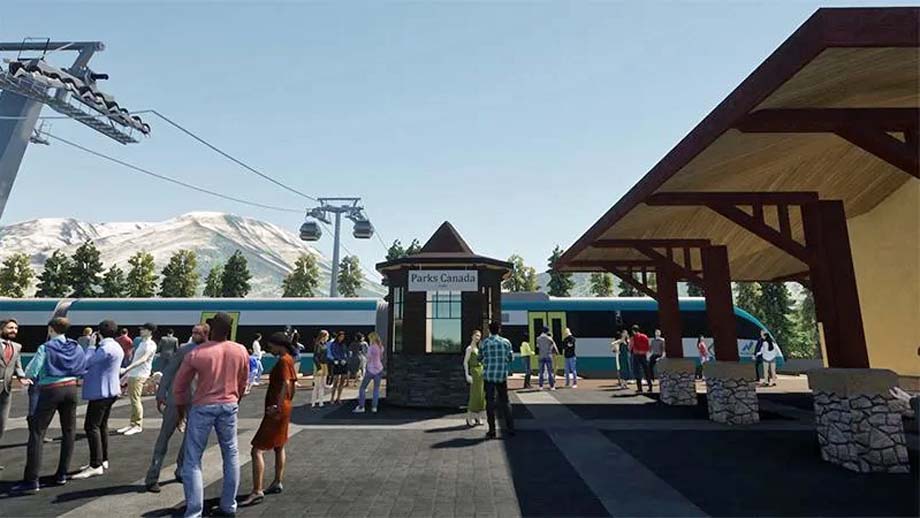
Banff Alberta - Canada's oldest and most visited national park may have been built around rail
tourism, but that gateway to Banff has left the station.
These days, most visitors drive to the town.
Long-time residents Adam and Jan Waterous of Liricon Capital Ltd. wanted to change that.
They've spearheaded a plan to revive the historic train station and create a transportation hub.
The plan has been presented to the town council for consideration.
On Monday, the area redevelopment plan (ARP) cleared its first hurdle.
Councillors voted unanimously to proceed with a first reading of the proposed ARP bylaw, which means the plan will go
to public engagement, including a public hearing next year.
The town's mayor, Corrie DiManno, said her vote in support wasn't an endorsement, but a part of the process to bring
the plan to the community to gather feedback.
Randall McKay, the town's manager of strategic initiatives and special projects, noted the historic station and
surrounding railway lands have been neglected for a long time.
"It has sat for so long, almost like an unwanted child or a castaway, operating primarily as a freight and
operations yard with very little reason to go there. I find it amazing the community has tolerated it in its current
state really for so long," said McKay.
The document outlines a vision of a new west entrance that would create a sense of arrival.
The focus is on restoring the historical station and transforming the grounds as a landmark destination, while
including elements to reduce visitor congestion and carbon emissions, according to Liricon.
Those ideas include an intercept parking lot, passenger rail facilities, a transit hub so visitors can connect to
shuttles and buses, as well as an aerial tramway system from the town of Banff to the Mount Norquay Ski
Resort.
Public submissions, many submitted in the summer of 2023, gave a taste of what some town businesses and residents
think.
Many were in support of the plan's aspirations to keep personal vehicle traffic at bay, hence the intercept parking
lot, which would intercept vehicles before they enter the town centre.
Ebony Rempel, CEO of YWCA Banff, spoke in support of the plan at the town's meeting Monday.
"The No. 1 component we feel that we're really here to support is around the railway service. The Y spends
thousands of dollars each year getting people to and from Calgary for medical appointments, different types of
supportive counselling," Rempel said.
Several local and regional environmental groups have spoken out against several elements in the plan and their
potential effects on wildlife corridors and the environment.
Some have requested the town's decisions on this ARP be put on hold until Parks Canada releases a detailed impact
assessment.
"The gondola proposed for the town and the larger environmental issues can't be separated. We're in a national
park. All these things are connected," said Jess Harding of the Bow Valley Naturalists.
Renderings provided by Liricon show a pedestrian plaza as part of the vision for Banff's railway lands.
The bylaw will face a second and third reading on the municipal level, but even if the town's councillors are all
aboard, the federal minister responsible for Parks Canada will get a final say.
Even after that whole process, projects will take more time and approvals to be shovel-ready.
If the vision sounds familiar, it's not entirely out of left field.
Liricon already pitched its eco-transit hub in 2018 with aspirations to build a 2,500 stall parking lot and gondola to
transport visitors to Mount Norquay Ski Resort.
That idea was shot down by Parks Canada in 2020.
It indicated the proposal would require the agency to alter its policies that limit development to protect the
ecological integrity of Banff National Park.
Waterous said many of the components outlined in the ARP, like passenger rail, a gondola, and environmental assessments
of such projects, would need approvals beyond the Town of Banff's jurisdiction.
It's a point McKay stressed as well.
"I think it is important that both council and the public understand this. Some of the proposed initiatives, in
fact, may or may not ever come to light," McKay said.
The area redevelopment plan will help anchor Liricon's vision to transform the town's west entrance, where the historic
Banff train station sits, into an arrival centre and transportation hub.
The town has long dreamed of creating a visitor and arrivals centre for people and cars in this part of
town.
The earliest reference dates to the 1992 Downtown Enhancement Concept Plan.
In that document, officials encouraged other methods of arrival to reduce the use of cars, such as passenger
rail.
Liricon has several projects and ideas in the works, including a proposed passenger rail connection between the
Calgary International Airport and Banff.
Author unknown.
(likely no image with original article)
(usually because it's been seen before)
provisions in Section 29 of the
Canadian Copyright Modernization Act.

